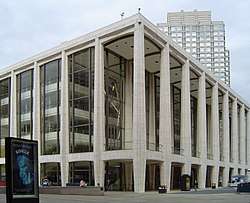Max Abramovitz
Max Abramovitz (May 23, 1908 – September 12, 2004) was an American architect. He was best known for his work with the New York City firm Harrison & Abramovitz.
Max Abramovitz | |
|---|---|
 | |
| Born | May 23, 1908 Chicago, Illinois |
| Died | September 12, 2004 (aged 96) |
| Nationality | American |
| Alma mater | University of Illinois at Urbana-Champaign School of Architecture, École des Beaux-Arts |
| Occupation | Architect |
| Awards | Resident of the American Academy in Rome (RAAR 1961) |
| Practice | Harrison & Abramovitz |
| Buildings | David Geffen Hall, Avery Fisher Hall, Phoenix Life Insurance Company Building |

Life
Abramovitz was the son of Romanian Jewish immigrant parents. He graduated in 1929 from the University of Illinois at Urbana-Champaign School of Architecture. While a Junior at Illinois, Abramovitz was a member of the Tau Epsilon Phi fraternity.[1] He later received an M.S. from Columbia University's architecture school in 1931. He also was the recipient of a two-year fellowship at the École des Beaux-Arts in Paris before returning to the US and becoming partners with Wallace Harrison from 1941 to 1976. In 1961, he was an invited resident (RAAR) of the American Academy in Rome.
Abramovitz died in September 2004 in Pound Ridge, New York, at the age of 96. His drawings and archives are held by the Avery Architectural and Fine Arts Library at Columbia University.[2] Abramovitz also received an honorary Doctorate in Fine Arts from the University of Illinois in 1970.
Work
- for work from 1941 through 1976, also see Harrison & Abramovitz
Brandeis University

Abramovitz was a friend and student of Brandeis University president Abram L. Sachar, who recruited him to work on his new campus.[3] For 30 years Abramovitz oversaw university planning, was a University Fellow and served on its Board of Overseers and the Creative Arts Commission.[3] Abramovitz designed the "vast majority of buildings on the Brandeis campus" during the mid-1950s, including:[3]
Other work
- Jerome Greene Hall[7] at Columbia University, New York, 1961
- David Geffen Hall at Lincoln Center, originally called Philharmonic Hall, and later Avery Fisher Hall, New York City, 1962
- three buildings for the University of Illinois at Urbana-Champaign, including the 1963 State Farm Center (formerly Assembly Hall), at its time the world's largest edge-supported dome, which is 400 feet in diameter and rises 128 feet above the floor, the 1969 Krannert Center for the Performing Arts, and the Hillel building
- Phoenix Life Insurance Company Building, Hartford, Connecticut, 1963
- Temple Beth Zion, Buffalo, New York, 1967 images
- the University of Iowa Museum of Art, and the Arts Campus of the University of Iowa, Iowa City, Iowa, 1968 onwards
- the International Affairs Building at Columbia University, New York, 1970[8]
- the U.S. Steel Tower (also known as USX Tower) Pittsburgh, Pennsylvania, 1970
- National City Tower, Louisville, Kentucky, 1972
- the Tour Gan, La Defense, Paris, France, 1974
- the Learning Research and Development Center building, University of Pittsburgh, 1974
- One SeaGate, Toledo, Ohio, 1982 (as Abramovitz, Harris & Kingsland)
- AEP Building, Columbus, Ohio, 1983 (as Abramovitz, Harris & Kingsland)
- Capitol Square, Columbus, Ohio, 1984 (as Abramovitz, Harris & Kingsland)
- the Hilles Library, a new home for the Radcliffe College Library at Harvard
- the Rockefeller Center, in New York City, and designed the interior of Radio City Music Hall in Rockefeller Center. Regarding the Classical Movement, he also created axial and symmetrical designs for the Embassy of the United States, New Delhi 1954, and the Kennedy Center for the Performing Arts 1961, in Washington.[9]
References
- Friedl, Jr., John L., ed. (1929). Illio (College yearbook). Champaign, Illinois. pp. 472.
- Kennedy, Randy (15 September 2004). "Max Abramovitz, 96, Dies, Architect of Avery Fisher Hall". The New York Times. Retrieved 1 Jan 2020.
- "Building Brandeis: Style and Function of a University". Brandeis University. Brandeis University. Retrieved 20 January 2019.
- Bernstein, Gerald S (1999). Building & Campus: An Architectural Celebration of Brandeis University 50th Anniversary. Brandeis University Office of Publications. pp. 34–37. ISBN 0-9620545-1-8.
- "The Three Chapels". Building Brandeis. Brandeis University. Retrieved 20 January 2019.
- "Style of a Campus". Building Brandeis. Brandeis University. Retrieved 20 January 2019.
- "Jerome Greene Hall - WikiCU, the Columbia University wiki encyclopedia". www.wikicu.com. Retrieved 2016-11-23.
- "International Affairs Building - WikiCU, the Columbia University wiki encyclopedia". www.wikicu.com. Retrieved 2016-11-23.
- Burden, Ernest (2012). Illustrated Dictionary of Architecture. China: The McGraw-Hill Companies Inc. p. 2. ISBN 978-0-07-177293-8.
External links
- Obituary from New York Times, 15 Sep 2004
- New York Architects Profile
- Information on Harrison, Abramovitz, & Abbe - from Emporis.com
- Information on Harrison & Abramovitz (the firm's earlier incarnation) - from Emporis.com
- Max Abramovitz Architectural Records and Papers, 1926-1995.Held by the Department of Drawings & Archives, Avery Architectural & Fine Arts Library, Columbia University.
- Architect Max Abramowitz, Designer of Avery Fisher Hall at Lincoln Center, Dies (Architectural Record, September 17, 2004)